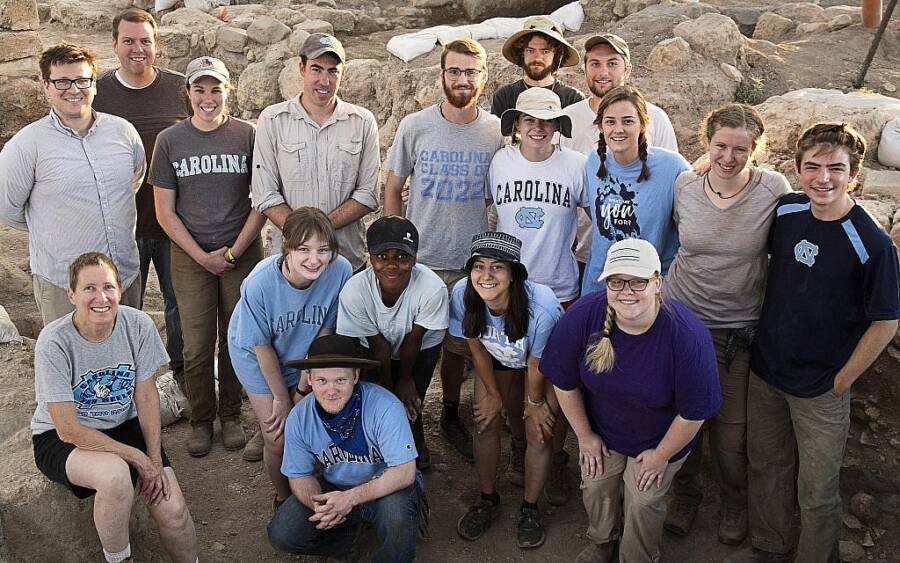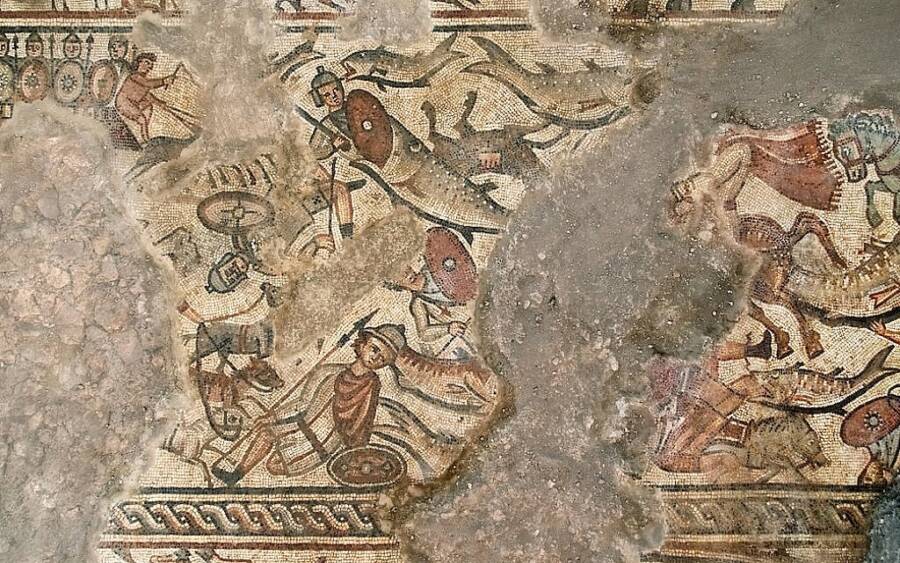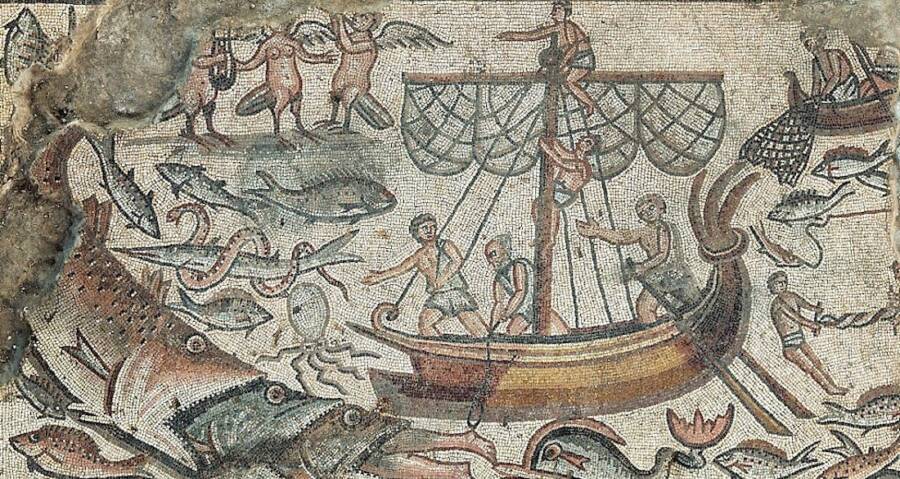In the last decade, the Huqoq Excavation Project has found mosaics depicting Noah's Ark, the parting of the Red Sea, and more in a 5th century synagogue.

Jim Haberman/UNC-Chapel HillThe mosaic depicts the story of Elim, in which exiled Egyptians sought refuge at a campsite after days of wandering without food or water.
An excavation led by professor Jodi Magness of the University of North Carolina at Chapel Hill has uncovered a 1,600-year-old biblical triptych mosaic made of tiny stone cubes (or tesserae) at a synagogue in the ancient Galilean village of Huqoq in Israel.
“We’ve uncovered the first depiction of the episode of Elim ever found in ancient Jewish art,” said Magness.
In an interview published by the university, Magness explained that her seasonal digs in Huqoq have been running for nine years. Each summer, she directs her students to find and analyze the remains of this late Roman synagogue to garner a clearer picture of the era and its inhabitants.
The mosaic discovered in the fifth-century synagogue depicts a scene from the book of Exodus. The 15th chapter and 27th verse describes the site of Elim in which the Israelites sought refuge after their exhausting travel.
“Elim is where the Israelites camped after leaving Egypt and wandering in the wilderness without water,” said Magness.

Jim Haberman/UNC-Chapel HillProfessor Jodi Magness of the University of North Carolina at Chapel Hill has led her students on excavations in Huqoq for nine years now.
Magness and her studious team have successfully uncovered historical artifacts like this before. They first uncovered mosaics at the synagogue in 2012, while mosaics depicting Noah’s Ark, the parting of the Red Sea, Jonah and the fish, and the Tower of Babel were all discovered between 2014 and 2017.
Last year, researchers found a mosaic they dubbed “a pole between two,” which depicts two spies sent to Canaan by Moses, as described in Numbers 13:23. Their latest finds, however, revolve around the story of Elim, from Exodus, and a chapter from the Book of Daniel.
One of the three panels depicts agricultural workers in loincloths harvesting dates, while another shows a series of wells and date palms.
“On the left side of the panel, a man in a short tunic is carrying a water jar and entering the arched gate of a city flanked by crenelated towers,” she explained.
The mosaic contains some actual writing, as well, which confirmed the assessment that this particular register revolved around the story of Elim. “An inscription above the gate reads, ‘And they came to Elim.'”

Jim Haberman/UNC-Chapel HillThe Huqoq Excavation Project discovered this mosaic depicting the Tower of Babel between 2014 and 2017.
The section depicting Chapter 7 of the Book of Daniel shows the four mythical beasts, representing four kingdoms, announcing the end of days. Two of the beasts — a bear with three ribs protruding from its mouth, and a creature with iron teeth — are all of mostly preserved in the mosaic. Photos of this particular register have yet to be made public.
“The Daniel panel is interesting because it points to eschatological, or end of day, expectations among this congregation,” said Magness. “The Elim panel is interesting as it is generally considered a fairly minor episode in the Israelites’ desert wanderings — which raises the question of why it was significant to this Jewish congregation of Lower Galilee.”
In 2016, a mosaic thought to depict Alexander the Great was uncovered at this synagogue in Huqoq. The debate rages on whether the tesserae actually do represent the historical figure or not. If true, it would be the very first non-Biblical story ever found in an ancient synagogue.
Another mosaic, depicting the Israelite warrior Samson of the Book of Judges, was also recently recovered here. Huqoq is simply a treasure trove of ancient art and one that continues to prove fruitful for Magness and the Huqoq Excavation Project.

Jim Haberman/UNC-Chapel HillIn the last five years, mosaics like this one which depicts the parting of the Red Sea were also uncovered in Huqoq.
Experts believe that the plentitude of and content in the mosaics found in Huqoq indicate that Jewish life in the area flourished under Christian rule. This stance has continued to challenge the status quo in academia — that Jewish populations in Huqoq declined and experienced a downturn during the 5th century.
“Our work sheds light on a period when our only written sources about Judaism are rabbinic literature from the Jewish sages of this period and references in early Christian literature,” said Magness, explaining that these written sources merely conveyed the views of those who wrote it — not the experiences of those they wrote about.

Jim Haberman/UNC-Chapel HillA mosaic depicting the Biblical story of Jonah, discovered in Huqoq in the last five years.
“So, archaeology fills this gap by shedding light on aspects of Judaism between the 4th to 6th centuries CE — about which we would know nothing otherwise,” said Magness. “Our discoveries indicate Judaism continued to be diverse and dynamic long after the destruction of the second Jerusalem temple in 70 CE.”
The Huqoq Excavation Project is comprised of experts from UNC-Chapel Hill, the University of Malta, the University of Maine, Western Carolina University, the University of Manitoba, the University of Toronto, Austin College, Howard University, Queens College, Baylor University, Brigham Young University, the Israel Antiquities Authority, and Tel Aviv University.
After learning about the biblical mosaics discovered in a 1,600-year-old synagogue in Israel, read about scientists uncovering the modern descendants of biblical Canaanites thought to have been wiped out. Then, learn about how a 13-year-old boy found a 1,000-year-old treasure linked to the Danish King Harold.





